Let’s talk about Warframe, Digital Extremes’s techno magic space ninja shooter/hack-n-slash. Free-to-play means a lot of things to a lot of different people. But if you ask, many will warn you about something called pay-to-win, a difficulty curve that draws you in with promises and power and then ramps up steeply, demanding large sums of money for any meaningful progression. And one thing gamers may tell you: free-to-play games might be fun for killing time on your phone but typically they can’t compete with indie and triple-A games that are developed with a “pay for the game” release structure (this despite the unrealistic assertion by some that games should simply always be free). And yet, that trend is changing in recent years.
We’ve written before about Dauntless, as well as covering it when it went cross-platform, a major advancement for any title. Here was an example of a game made completely free to download and play on any platform, a game which rewarded teamwork and strategy, and in which all kinds of cosmetics were the reward for supporting the developers with your purchases rather than cheating your way to high level gear. It was fair. It encouraged you to actually play the game rather than buy your way through it, and it didn’t ask for an unreasonable grind to do so. Dauntless is a breath of fresh air and shows what games are capable of, even given a free-to-play model in which a player might play for a year and never spend a single cent.
So what if I told you about a title I’ve sunk hundreds of hours into, a title whose development goes back close to seven years (though I’ve been in it for only a couple), a title which also isn’t pay-to-win, that perhaps you’ve never heard of or been too scared by its reputation to try. What if I told you it was worth another look? There’s another game out there that’s been trending strongly, holding its own against even triple-A titles. And that game is Warframe.
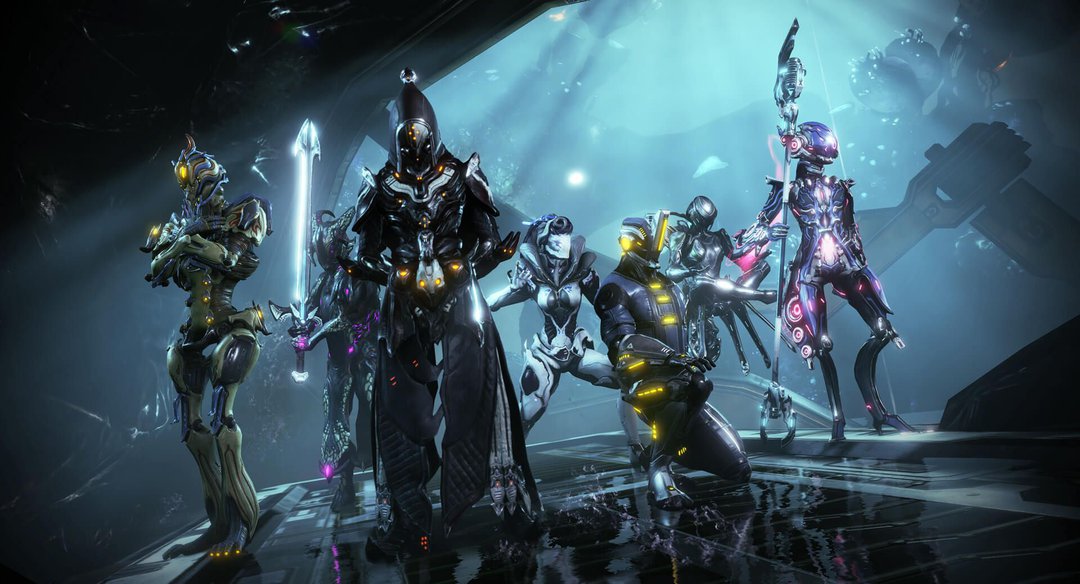
Suit up, Tenno. There's a frame combat style out there for everyone!
Leveling Its Sights
Where do I even begin? The nearly nonexistent plot whose story doesn’t seriously kick off until around a hundred hours of gameplay into the star chart? The game’s extremely limited “tutorial” missions that get your orbiter up and running, only to drop you into a universe full of systems upon systems with zero explanation of how to navigate any of them? Maybe I should start by talking about how to actually get a weapon other than your starters, something I didn’t figure out until I’d put nearly a dozen hours into the game. And even then I didn’t understand what mods were and how they were linked to the traditional concept of level-ups. If you’re already backing away from this article, hands up in the air, looking for a polite excuse to find the bathroom and run in the other direction, you’re already getting a sense of why this game’s following can be described as cult.
And yet, look back a few years and you can already see how Warframe was pushing the thinking of what a looter shooter should be. This tiny Canadian studio, Digital Extremes, that’s grown so much year over year had big aspirations. Even as early as 2015 you could see articles pointing to Warframe as a growing competitor in the looter shooter genre, taking risks and pushing boundaries. It’s biggest competitor? The triple-A title, Destiny. Talk about setting your sights high! Since its release, Warframe has been a top played title on Steam and remains in its top 10 highest player counts to this day. It’s no secret amongst the communities of those two games that players flow from one to the other as each makes advancements or blunders. These days Destiny 2 is riding high, but that ebb and flow still continues.
How, despite all the obtuseness of systems layered over systems, is this possible? How can this dense and seemingly impenetrable game we call Warframe stand up to the likes of Destiny? And why do I keep diving deeper into each new challenge within its universe of magic space ninjas, braving each new system and feature I need to learn, to the degree that I feel the need to take valuable time out of your day to tell you about it?
I’m glad you asked. Ordis, pull up my presentation!
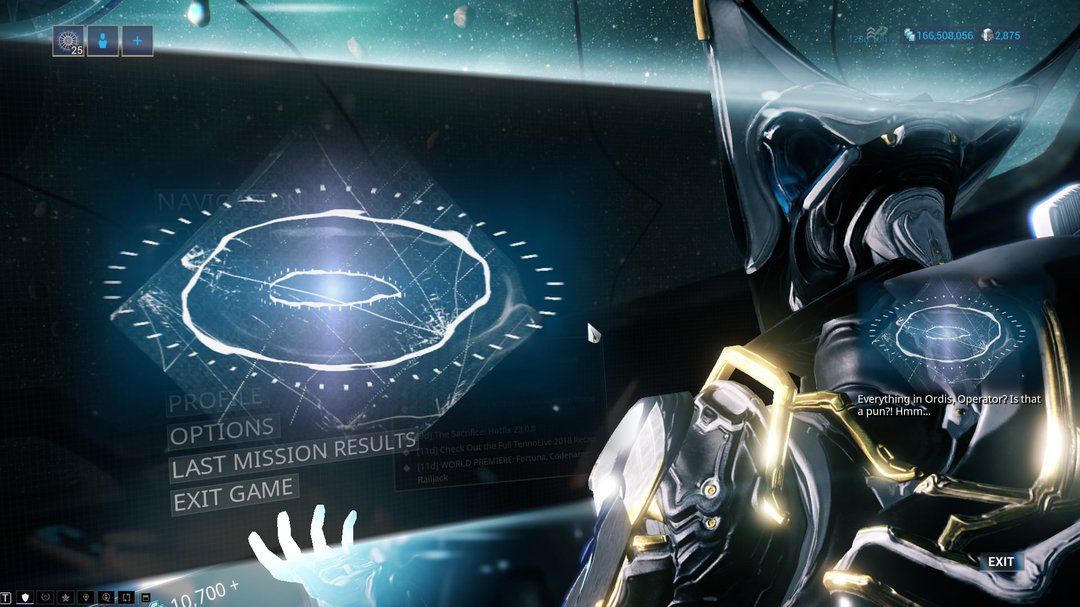
Is that a pun? On second thought, Ordis, I'll handle this myself.
Go With The Flow
This game, in my humble opinion, is still rather unique and novel in what it offers. I keep coming back for those feelings in the core gameplay I can’t get anywhere else. Each mission will see you going after one of several static objectives, perhaps defending a point or assassinating a boss enemy, and it will procedurally generate a level with a particular planet’s tileset for you to play in; the overall layout will be different each mission, but you can still learn the “tiles,” the rooms, that make up the map to learn the best ways to get around each one. It’s not the novelty of each level where the draw lies, feeling samey anyway after your 50th run on a planet, but rather how Warframe allows you to tackle them. You see, in most games your avatar needs to finish its animations for jumping or attacking before it can do anything else. Warframe instead allows you to chain your attacks and parkour moves, allowing you to do some truly amazing feats. You can wall run before bullet jumping high into the sky, drawing you gun to drop several enemies before initiating a plunge attack to finish foes on the ground with your sword, then roll away to cover, dodging incoming fire. I don’t get this feeling of flow from any other game I play, and I haven’t tired of it even after hundreds of hours of dropping baddies.
Layer on top of that the builds. I’m a fan of old school Guild Wars (the original, though I also love the second one), and one of the things I loved about that game was your ability to pick from hundreds of skills, combining them into all sorts of wacky builds. Did they always work? You bet they didn’t! But the game didn’t care. Maybe you flubbed a mission royally because an idea you had fell flat on its face, but those builds were yours to experiment and play with. Warframe captures this feeling like Amprex firepower in a bottle. You’ll hit max level with your chosen frame and weapons in little time, and as you come up against ever increasing challenges you’ll learn how mods work and combine with weapons and frame powers. You’ll add extra damage to your weapons. Then you’ll start to ask how critical hit or status builds work. You’ll pay more attention to weapons that work better in these regards. Similarly, you’ll find new ways to push your favorite frames’ powers to new heights. And while you’ll discover powerful “meta” builds that many players gravitate towards, you’ll also find other voices (several of my favorite YouTubers for example) who will tell you there’s no one right way to mod a weapon or frame. You play with a gun, you throw a crazy set of mods onto it, and you have fun. At the end of the day, that’s what matters most, doesn’t it?
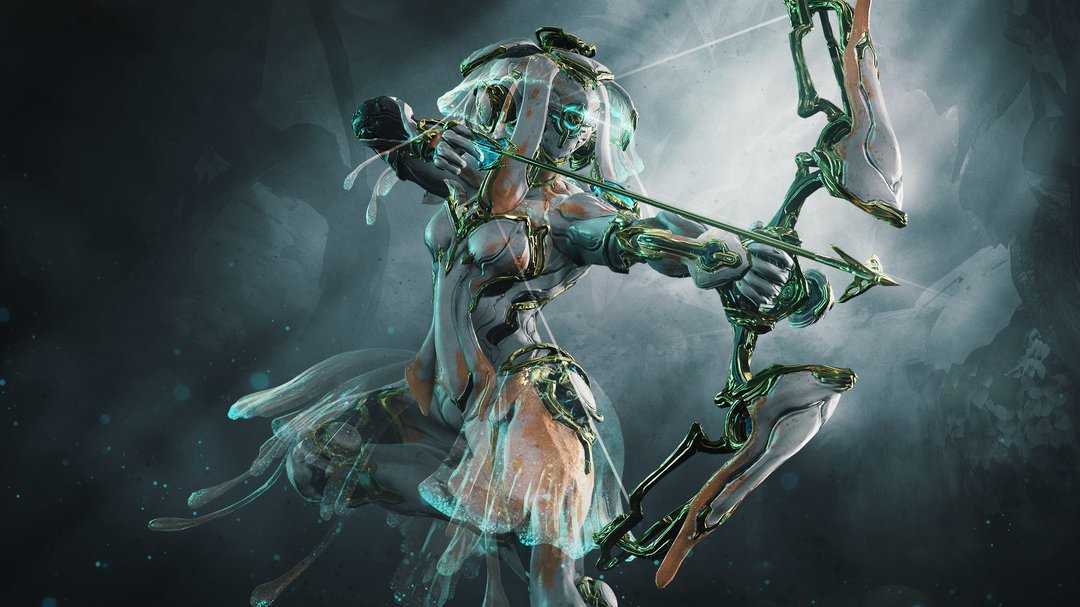
The art direction and graphics for this game never cease to drop my jaw.
Ever Greater Heights
Another thing I love about Warframe is that it’s not afraid to be mercilessly brutal to you. But not, perhaps, in the way Dark Souls is. In Souls games, bosses will smack you around for timing your rolls just wrong, not learning their patterns or perhaps not exploiting a weakness of theirs properly. The focus is always on the foe. In Warframe, by comparison, the focus is on you and how you can make the most of the tools currently at your disposal. It’s a subtle shift, but one that feels truly empowering in a way I never got out of the Souls titles. For example, to progress to each new planet you’re required to beat a junction, a small space station hub within the transport network guarded by an enemy frame. These AI opponents face you in single combat, all your tricks and powers versus theirs. You’ll defeat the first few junctions with little trouble, but after a point you’ll reach opponents who kill you in one shot. Unfair, you’ll think at first, but then the challenge hits you. How can you play differently with what you have. Perhaps you revisit a frame ability you haven’t used much until now, pushing your play style in a new direction. Maybe you take some time to craft a new weapon or frame better suited to countering your foe. You might take a look at your mods, pushing your power up to the next level and overwhelming your foe with superior firepower. Maybe you figure out a sneaky way to backstab them.
Warframe is constantly, gently nudging you to take your game to the next level. Enemies rise from level ten to twenty to thirty, matching your frame’s level. Then you progress to level forty enemies, the challenge growing past the simple leveling ability of your frame. You push on farming up new mods and trying new combinations of weapons and special frame powers. At some point you find you’re killing those foes too easily and you get curious about that level fifty area you haven’t touched yet. Before you know it, you’re asking yourself how tough those level 80 enemies really are. You finish modding up your newest favorite build and you need someplace to push it to its absolute max. Just how strong are you? Your favorite YouTuber just did a one hour survival mission in one of the most brutal maps of the game, fighting level 100+ enemies by the end of it. You could do that right? One failed mission is all you pay for trying.
At some point I stopped fearing higher level content like I did in other games. I didn’t even care if I had a group to watch my back or not. I’d fly my lander in solo, dropping into hordes of enemies, my favorite frame shattering her glass armor and swirling it around her in a blender vortex of destruction, fluidly leaping and spinning between enemies, tearing them to shreds while flipping my aim across the battlefield, laying waste to any who opposed me. Of course, you can enjoy Warframe with friends, which is something I’m happily doing more of these days too, but even before that started I was perfectly happy by myself with that thrill of testing new builds and watching bigger and bigger numbers pop off enemies in validation as I worked my way through new challenges. Warframe is a total power trip, and it’s lovely.
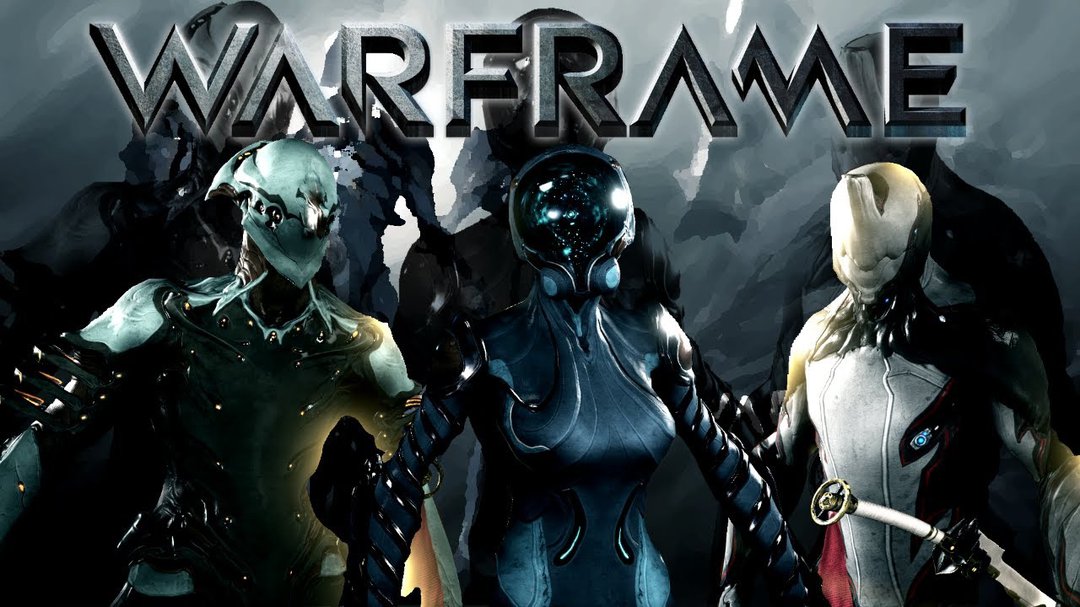
Imagine a game where your starter was as viable in the end game as at the outset? These three frames are just that.
Beauty Through The Flaws
I’m not going to make any illusions here that Warframe is a perfect game by any stretch. Many of the game’s dedicated community can point out, and have pointed out, many things that become more apparent the longer you play regarding the long-term viability of the game. I’d like to say I’ve put enough hours in at this point to see the merit in the concerns they voice, that once the glitz and glam of clearing through the star chart and its quests wears off, when grinding for the newest content becomes the goal in itself as we wait for dedicated raids to make their way to the game, something to do with all the wondrous, shiny gear we’ve acquired, one can come to a point of questioning if the game is still fun.
And for me, at least for now, I can say that, yes, it is. At the end of the day, there are still new builds to try, new ways to play, new challenges to explore (some more grindy than others), but through it all I still derive that same satisfaction of testing my builds and partaking in Warframe’s satisfying gameplay loop. And really, there is no other game that does what Warframe does, allowing me to flip off walls and pulling perfect 30 foot leaps into the sky before laying waste to massive amounts of enemies in a well-timed ballet of death. Or, you know, opening a small portal in front of the sun and channeling a solar flare into my foes. Whatevs.
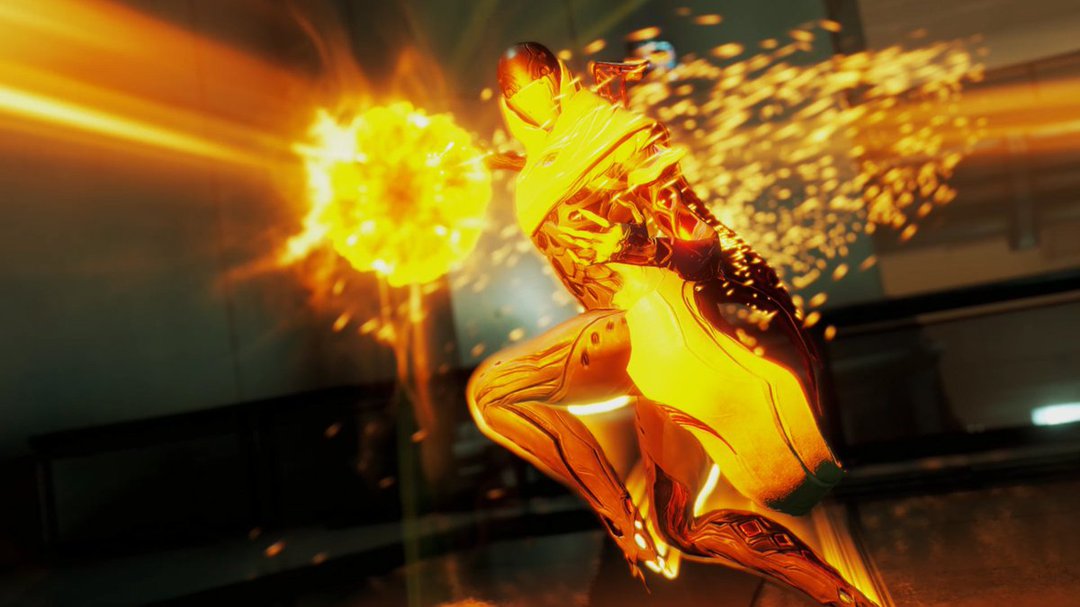
The Wisp frame is quickly becoming one of my personal favorites, good for team support as well as asbsolutely melting enemies!
Is there still a lot to fix in this game? For sure. The developers themselves describe their own game as containing “spaghetti code.” Fix one thing and set off a string of other problems. Untangling it and polishing up some of the base aspects of Warframe is high on many veteran players’ lists, and while the dev team continues designing and releasing brand new content, concerns about these quality of life fixes grows. Cross play might never be a thing, but cross save progression has been stated as a new focus, much requested by the community at large. Still there’s no telling how far off it could be. A year or more maybe is my own guess, given DE’s history of timeframes, and this is given the fans have been asking for at least that long already. Maybe I’ll be pleasantly surprised, but holding my breath isn’t a requirement for my continued enjoyment of the game.
Digital Extremes, as a studio, is at something of a crossroads of growing pains. They’ve gone from a small indie deeply in touch with their dedicated player base to a large, some would say more out of touch studio focused on a style of “next big thing” releases, unable or unwilling to untangle the Gordian Knot of code that holds up their game. Their newest updates, offering players the chance to crew self-build cruisers and take to the stars in new ways, shows DE has never lost their ambition and drive to make the game they don’t see anywhere else, but it also speak to possibly locking themselves into timelines that reduce their agility, even as the more level-headed of the player base try to call attention to the most critical of needed fixes. And DE has always had a sort of love/hate relationship with “overpromise, under deliver” for whatever the reason. What they release seems to take several patches and updates to get up to what was previewed. Like all things Warframe, the polish takes time. Lots of time.
Though to DE’s credit, several frames that have wasted away on the sidelines have recently received meaningful reworks, new content is making its way into the game, and a proposed armor rework on enemies promises to help retune some of those end-game concerns vets have. Even despite the concerns, it seems things are still moving forward in an overall positive direction.
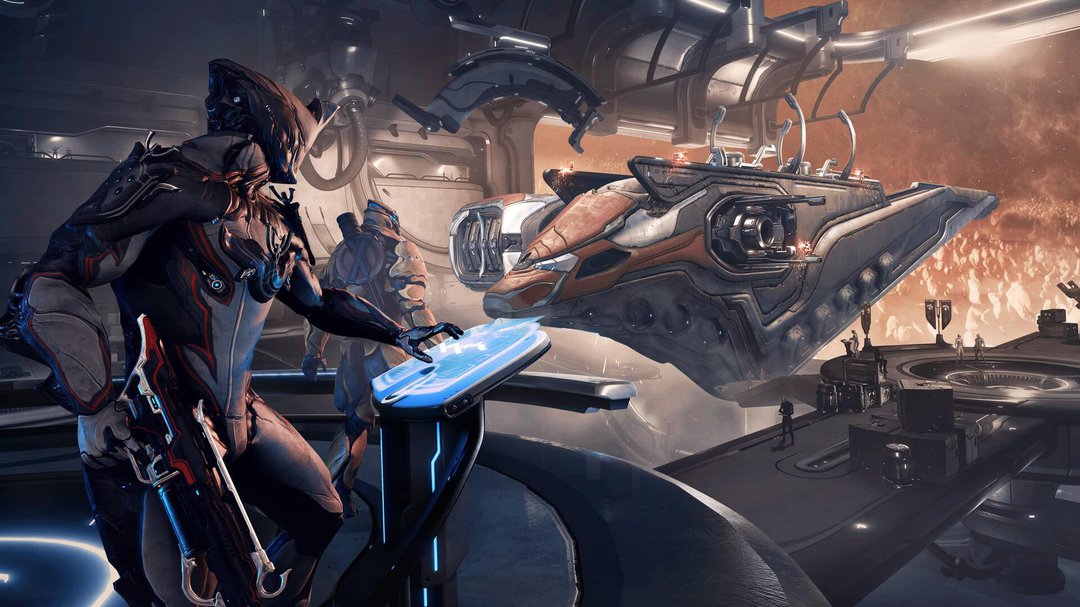
The Empyrean update adds Railjacks, a new form of firepower that combines ship to ship battles with your ninja hit-and-run.
Living In The Now
In a way, Warframe reminds me a lot of another game I lovingly wrote about: Project Zomboid. Nearly four years ago (dear goodness help me rereading work that old!) I asked if it was ok to love an unfinished game. To which my answer was, yes, if you take the game for what it currently is rather than anything it could be. It’s difficult for us as lovers of games to let go of that frustration when we see a title not living up to the potential we know it has. Potential, as in Warframe’s case, that one day may reach all new heights. After lots more time. But if you are reading this as a new player to Warframe, hearing about it for the first time or perhaps returning after several years away, the game on offer today is solid. It’s worth your time. You can judge it, flaws and all, on its merits today, and while you may find it wanting in some regards, as I have, you will also find it shining in many others, as I have.
There are enough features and things to keep you busy in the game that this article could easily run on into the multiple thousands of words, so I’ll leave you with this thought instead. If you’ve come this far and are still curious about Warframe, please go and try it. At the price of free, you lose only the time spent to download and play it if you don’t like it. I kicked DE some money for in-game purchases, but only after I’d sunk a couple hundred hours into the game, satisfied with my experience, wanting to support the developers further, and eager for the next several hundred hours of gameplay. Rookie numbers, as the long-term community puts it lovingly. For some, Warframe will always remain dense and somewhat inaccessible, and that’s ok. As I’ve said in the past with literally every board game I’ve reviewed, not every game is for every gamer. But I hope that if you’ve read to the end of this article, you still carry that spark of curiosity. Perhaps, like me, you’ll check this game out, you’ll tumble down this rabbit hole as well, and perhaps you too will find beauty in the uniqueness that is Warframe.